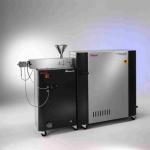ABSTRACT
A HAAKE PolyLab OS torque rheometer, equipped with a Mixer was used to test four different soft PVC samples. The type and amount of plasticizer was varied. The corresponding torque curves helped to differentiate the formulas. The PolySoft Mixer data evaluation is explained in detail in this application note, and valuable hints are given for substituting PVC blend ingredients, e.g. plasticisers, stabilisers.
Introduction
PVC blends are complex mixtures of PVC particles, fillers, lubricants, stabilisers and plasticizers. They are used to provide unique properties to a wide range of end products.
However, manufacturers are often forced to modify these complex recipes due to technological advances, cost pressures or regulatory requirements. For example, two EU directives came into force, 2002/95/EG (RoHS) restricting hazardous lead stabilizers in the waste. CaZn systems now are well investigated, also in Mixers tests. Another example is the precautionary EU regulation on phthalate plasticizers in children’s toys which was widely discussed in the press.
Plasticisers are used in the PVC industry to soften the product.
Approximately 100 different plasticizers are in use, which represents an estimated 7 billion EUR market. The type and amount of plasticizer have a major influence on the melt and processing behaviour when investigating alternate blends. In addition to tests on the final product, small-scale tests in a mixer are advisable before starting production. The mixer test is used for quality control during production.
The HAAKE Rheomix system offers a quick method to characterize the influence of plasticizers on the plasticization and flow process of PVC dry blends. Using HAAKE PolySoft OS Software for mixer tests, the evaluation and comparison of different samples is quite quick and easy. Different routines are available, and it is also possible to create customised evaluation methods. Maxima, minima, points of inflection, thresholds and slopes can easily be calculated from all measurement data curves.
A complete copy of this application note is available by requesting LR-59.

